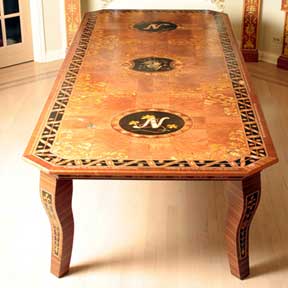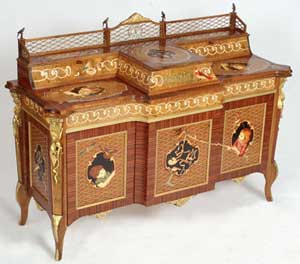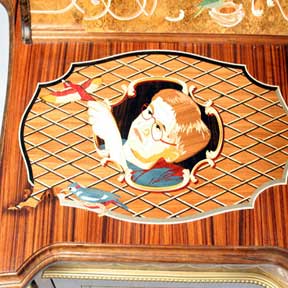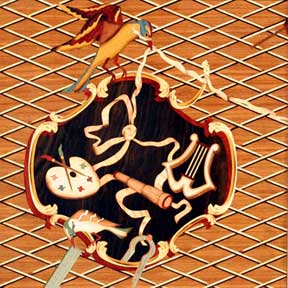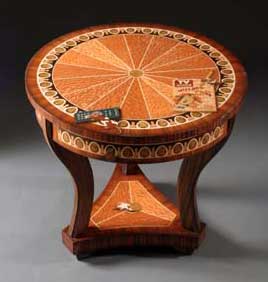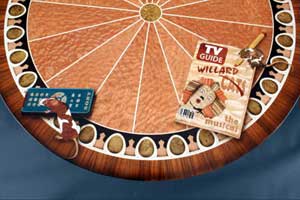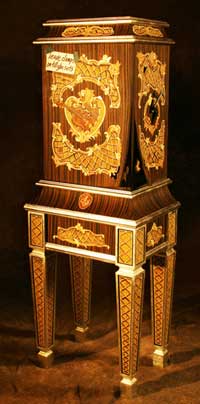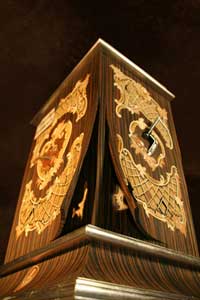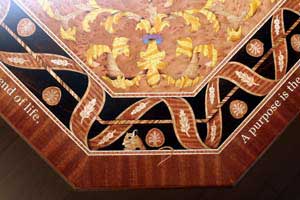
There’s marquetry, which consists of pictures made of inlaid wood and veneers. Then there is trompe l’oeil, which adds the appearance of three dimensions to inlay in order to fool the eye. Greg Novosad not only does compelling inlay and trompe l’oeil; he goes a step further by weaving a storyline into what, for most, is simply a beautiful static picture.
As impressive as his work is, it turns out that woodworking is a fairly recent iteration of his artistic talents. “My dad had a tiny, dangerous table saw that he made himself,” Greg recounted. “The table was about 12 by 18 with no wings. He built a lot of pine display cabinets, and did DIY home improvement projects in the garage, mostly before I was born. My first experience was woodshop in high school, but it was worthless except for learning shop safety. No one came out of there building anything of value.
“I started a house painting company to pay my way through college, and graduated with a degree in computer science. During that time, I did woodworking at home, mostly for myself. Once I became a computer consultant, I bought a foreclosed home. With that, my woodworking hobby became home improvement, building furniture and fixing up the house. In 1987, I started my own computer consulting company and did that for 13 years, growing it to 600 employees before selling it. I retired at age 40 in 2000.
“During those years, I spent a decent amount of time in Europe, and developed a love for classic architecture and furniture. That was, for me, a life changing experience, and skewed me into building decorative furniture. I decided to get good at woodworking, and to that end, I put together a self-training program. It consisted of a series of projects of increasing difficult, from joinery to decorative design.
“I did my first marquetry in 2005. During high school I had taken art, which unlike shop, was an excellent program at that school, and art was always part of my life. Thus, it was a natural transition to want to decorate furniture. After my first marquetry piece, I decided that was what I wanted to do. I bought a laser and started focusing on my inlay work.
“My first laser cut piece, called Fit for a King, is a 20-foot-long table containing some 8,000 pieces of inlay. Hidden in the border are animals, birds, cherubs and even mythological creatures. Inlaid along the edge are some of my favorite quotes.
“Birds of Frey is perhaps my coming of-age piece. The 18th century style breakfront buffet sports 21 menacing birds in eight major panels. The birds are all trying to dismantle the inlay, fraying the edges and elements. Attempting to defend the piece are inlays of my daughter, playing tug of war with one bird, my son, shooting a bird with a dart gun, and my wife and I, on the top panel doing our bit to save the inlay from the birds. In addition to the ones inlaid in the piece, four more cast, gilded birds sit atop a pierced wooden basket weave gallery, waiting their turn to attack.
“From this piece onward, I started to incorporate story lines into my inlay, moving it beyond static trompe l’oeil. Clicker Control is a good example. It has an egg and dart motif inlay, but the characters in this story are mice. They don’t like what is on TV, so one crosses out Cats on the TV guide and replaces it with Willard, while another grabs the remote control to change the channel.
“Rascal Rodents is a Rococo cabinet on stand with 17 defects caused by the rodents. On one corner, the primary sheets of veneer are peeling while in other spots, inlays pop up, all contributing to the very three dimensional appearance of the inlay. The front door sports a tacked sign that says ‘Leave clamps on til glue sets,’ but before the glue is set, the rodents are stealing the clamps when no one is looking. That’s what is causing the defects. Open the door and look inside and you’ll find an inlaid mouse caught red handed with two real clamps, and a two-dimensional mouse caught in a real mouse trap. Similarly, a real metal clamp, cut and built into the side of the cabinet, pops out of the inlay, extending beyond the plane of the inlaid panel.”
What started out as something to satisfy his own creative urges has now become a budding business. “For those interested in buying my work,” Greg explained, “I’ve created Divine Design. It allows you, as a customer, to go onto the website and choose the shape and size piece of the furniture, a pattern or motif, and a story line. Initially, the motif options will be egg and dart, running coin, French ribbon and rococo, all classic styles. At that point, you can personalize the storyline with text, which will eventually influence the inlay on the piece.
“Once you have what you want, you can order it and get it in about six weeks. A personalized version of Clicker Control, for instance, would cost about four thousand dollars. You could get anything from a simple marquetry panel in a kitchen an entire piece of furniture. Hobby woodworkers can order one or more panels to include in their own building projects as well. The other side of the business, Studio Design, is where I express my own creativity.”
Surprisingly, all this came about in a very short time, spawned by Greg’s focused intent to teach himself the level of woodworking he decided he wanted to do. He approached it the same way he approached building a business: with organization and a plan in hand.
“Woodworking is a journey,” Greg insists. “It is important to visualize your endgame, and that demands an organized plan to get there.”
That, I suppose, is the storyline entwined in all of Greg’s work.
